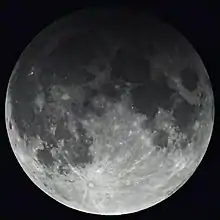| Partial lunar eclipse 7 September 2006 | |
|---|---|
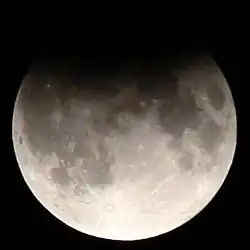 From Bucharest, Romania, 18:37 UTC | |
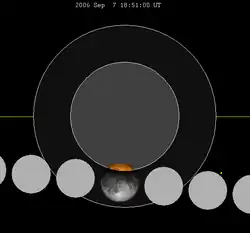 The Moon's path through the southern edge of the Earth's umbral shadow | |
| Series (and member) | 118 (51 of 74) |
| Gamma | -0.9262 |
| Magnitude | 0.1837 |
| Duration (hr:mn:sc) | |
| Partial | 1:31:06 |
| Penumbral | 4:14:23 |
| Contacts (UTC) | |
| P1 | 16:44:07 |
| U1 | 18:05:47 |
| Greatest | 18:51:19 |
| U4 | 19:36:53 |
| P4 | 20:58:30 |
 The Moon's hourly motion across the Earth's shadow in the constellation of Aquarius | |
A partial lunar eclipse took place on 7 September 2006, the second of two lunar eclipses in 2006. The tables below contain detailed predictions and additional information on the partial lunar eclipse of 7 September 2006.
Details about this eclipse
Penumbral magnitude: +1.13488 (+113.488%)
Umbral magnitude: +0.18568 (+18.568%)
Gamma: -0.92619 (-92.879%)
Greatest eclipse: 2006 Sep 07 at 18:51:20.1 UTC
Ecliptic opposition: 2006 Sep 07 at 18:42:03.3 UTC
Equatorial opposition: 2006 Sep 07 at 18:00:00.9 UTC
Sun's right ascension: 11.080 h
Sun's declination: +5.91°
Sun's diameter: 1904.8 arcseconds
Sun's equatorial horizontal parallax: 17.4 arcseconds
Earth's shadow's right ascension: 23.080 h
Earth's shadow's declination: –5.91°
Moon's right ascension: 23.110 h
Moon's declination: -6.74°
Moon's diameter: 2006.6 arcseconds (6.282% larger than average)
Moon's equatorial horizontal parallax: 7364.6 arcseconds
Moon's longitudinal position: 0.5° West
Moon's latitudinal position: 1.3° North
Moon's libration position: 338.7° (NNW)
Moon's penumbral diameter: 9387.36 arcseconds
Moon's umbral diameter: 5577.84 arcseconds
Northernmost civil twilight/daylight boundary: 83°15'36.9" South, solar midnight
Northernmost nautical twilight/civil twilight boundary: 78°05'36.9" South, solar midnight
Northernmost astronomical twilight/nautical twilight boundary: 72°05'36.9" South, solar midnight
Northernmost nighttime/astronomical Twilight boundary: 66°05'36.9" South, solar midnight
Southernmost latitude to see full darkness for at least 9 hours: 53°43'09.3" South
Southernmost latitude to see full darkness for at least 8 hours: 64°18'04.1" South
Southernmost latitude to see full darkness for at least 7 hours: 69°30'29.1" South
Southernmost latitude to see full darkness for at least 6 hours: 72°35'19.0" South
Southernmost nighttime/astronomical twilight boundary: 77°54'23.1" South, solar midnight
Southernmost astronomical twilight/nautical twilight boundary: 83°54'23.1" South, solar midnight
Southernmost nautical twilight/civil twilight boundary: 89°54'23.1" South, solar midnight
Southernmost civil twilight/daylight boundary: 84°55'36.9" South, Solar noon
Eclipse times
| Contact | Date & time (UTC) |
|---|---|
| P1 | 2006 Sep 07 at 16:43:59.5 UTC |
| U1 | 2006 Sep 07 at 18:05:43.2 UTC |
| Greatest | 2006 Sep 07 at 18:51:20.1 UTC |
| U4 | 2006 Sep 07 at 19:37:29.8 UTC |
| P4 | 2006 Sep 07 at 20:59:02.0 UTC |
Eclipse season
This is the first eclipse this season.
Second eclipse this season: 22 September 2006 annular solar eclipse
Visibility
It was completely visible over most of Africa, Europe, Asia and Australia.
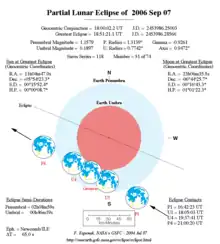
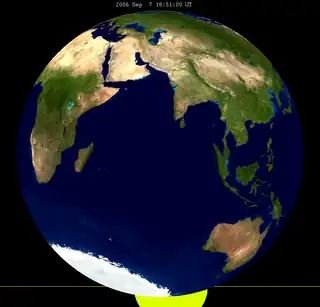
A simulated view of the Earth from the center of the Moon at maximum eclipse
Map
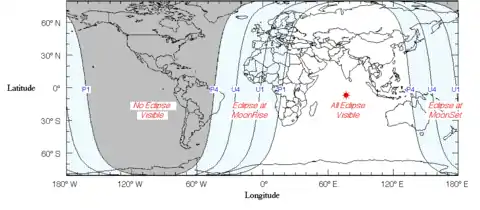
Photos

Degania A, Israel
.jpg.webp) North Wales, UK
North Wales, UK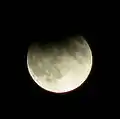
.jpg.webp)
.jpg.webp) Shizuoka City, Japan
Shizuoka City, Japan
Relation to other lunar eclipses
Eclipses of 2006
- A penumbral lunar eclipse on 14 March
- A total solar eclipse on 29 March
- A partial lunar eclipse on 7 September
- An annular solar eclipse on 22 September
| Lunar eclipse series sets from 2006–2009 | ||||||||
|---|---|---|---|---|---|---|---|---|
| Descending node | Ascending node | |||||||
| Saros # and photo |
Date Viewing |
Type Chart |
Gamma | Saros # and photo |
Date Viewing |
Type Chart |
Gamma | |
113.jpg.webp) |
2006 Mar 14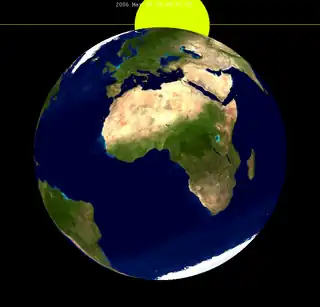 |
penumbral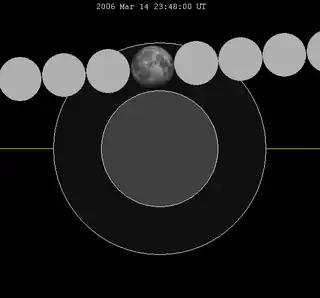 |
1.0211 | 118 |
2006 Sep 7 |
partial |
−0.9262 | |
123 |
2007 Mar 03 |
total |
0.3175 | 128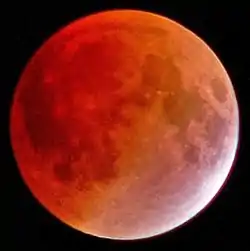 |
2007 Aug 28 |
total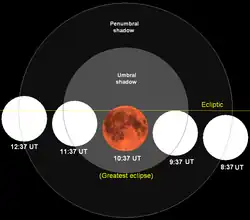 |
−0.2146 | |
133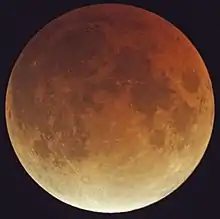 |
2008 Feb 21 |
total |
−0.3992 | 138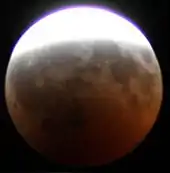 |
2008 Aug 16 |
partial |
0.5646 | |
143 |
2009 Feb 09 |
penumbral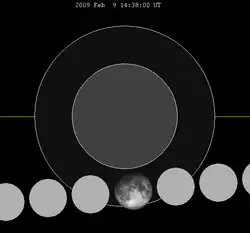 |
−1.0640 | 148 |
2009 Aug 06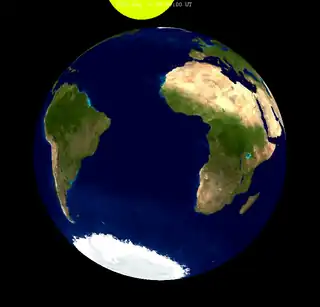 |
penumbral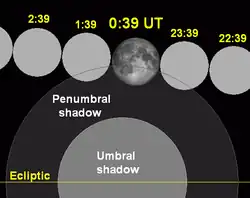 |
1.3572 | |
| Last set | 2005 Apr 24 | Last set | 2005 Oct 17 | |||||
| Next set | 2009 Dec 31 | Next set | 2009 Jul 07 | |||||
Metonic cycle (19 years)
This eclipse is the first of four Metonic cycle lunar eclipses on the same date, 7 September, each separated by 19 years:
The Metonic cycle repeats nearly exactly every 19 years and represents a Saros cycle plus one lunar year. Because it occurs on the same calendar date, the earth's shadow will in nearly the same location relative to the background stars.
|
|
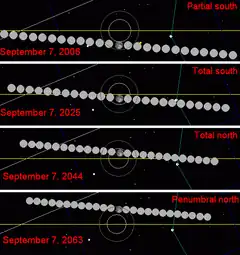 |
Half-Saros cycle
A lunar eclipse will be preceded and followed by solar eclipses by 9 years and 5.5 days (a half saros).[1] This lunar eclipse is related to two partial solar eclipses of Solar Saros 125.
| 2 September 1997 | 13 September 2015 |
|---|---|
 |
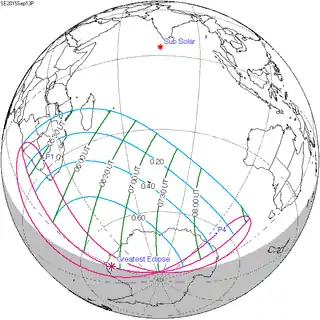 |
Tritos series
- Preceded: Lunar eclipse of October 8, 1995
- Followed: Lunar eclipse of August 7, 2017
Tzolkinex
- Preceded: Lunar eclipse of July 28, 1999
- Followed: Lunar eclipse of October 18, 2013
See also
- List of lunar eclipses and List of 21st-century lunar eclipses
- May 2003 lunar eclipse
- November 2003 lunar eclipse
- May 2004 lunar eclipse
- File:2006-09-07 Lunar Eclipse Sketch.gif Chart
References
- ↑ Mathematical Astronomy Morsels, Jean Meeus, p.110, Chapter 18, The half-saros
External links
- 2006 Sep 07 chart: Eclipse Predictions by Fred Espenak, NASA/GSFC
- Hermit eclipse: 2006-09-07
- Photo
- Photo from New Zealand
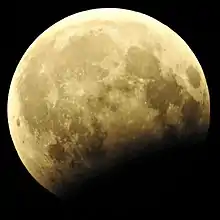
_(cropped).jpg.webp)
